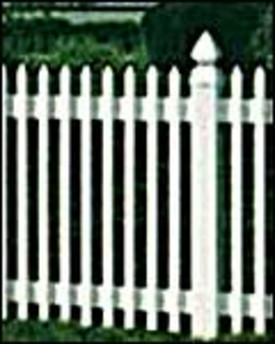 The classic white picket fence comes in a wide variety of styles. Posts, boards, and caps define the style of each fence. |
Fences serve a wide variety of functions, depending on the size of the property, the goal of the homeowners, and the style of the architecture. Fences may feature spaced boards or solid faces, depending on the desire for privacy and the look homeowners wish to achieve. Fences can be concave or convex, scalloped along the top or straight edged. Fence styles vary widely from the standard to the custom, and often reflect regional and architectural preferences. The key to any fence project is to determine the need and the budget, then work with the available components to create the style.
Fence Components
Fence styles are determined by four key factors: height, board width, spacing of the boards, and board profiles. Picket fences are shorter, usually four feet or less, with narrow boards, typically 3-1/2-inches wide. In contrast, a true privacy fence will be at least seven feet tall, with tongue and groove boards that completely block the view. Other fence styles use board width and spacing, height, and number of rails to define the style. Woven fences, like lattice and basket weaves, use the style of weave as their defining element.
Boards
Boards come in a variety of styles and widths. Their shapes and tops define them. A classic picket fence features a Gothic, or pointed, top. Stockades come to a point at the top of the board, as well. A more ornate picket might feature the French Gothic with a nip at the neck. Flat-topped boards and dog-ear styles are more commonly featured in modern pickets, shadow box, and tongue-and-groove fencing.
 Board Styles (left to right): Dog ear, flat top, French Gothic, Gothic |
Posts
Posts may be used simply as structural members or to enhance the design of the fence. With tongue-and-groove fencing, posts may be constructed of contrasting woods or painted an accent color to create a bold statement. Posts may terminate at the height of the boards or extend above them, often with ornamental caps. Sections can be attached to the face of the post, the back, or along the sides allowing the post to stand out in relief from the sections along the face. Posts may be rounded, squares, beveled, or rough-hewn, depending on the style.
Caps
Caps are added to the tops of posts to provide a finished look or further enhance the style. Like posts and boards, caps come in a variety of styles and are matched to their period or vernacular style. Post caps may be modern, Victorian, classical, colonial, gothic, one of several vernacular architectural styles like Cape Cod, Newport, or ranch.
 A classic New England-style post cap |
 Gothic-inspired post cap |
||
 Pyramid-style post cap |
 Ball-style post cap |
 Crossed rails define a crossbuck-style fence. |
Fence styles
In essence, all fences have similar structure, unless constructed of brick, concrete, or stone. Commonly referred to as “board and post” fences, most fences are sold as sections, with a horizontal structural member to which “boards” are attached. Picket, stockade, and privacy fences are all constructed in this way. Each section is joined at a post, which anchors the fence to the ground and the sections to one another. Posts, caps and tops may be stylized to match the period or theme of the fence.
Ranch fences
Ranch fences may have two, three, or four rails and are available in post and rail or crossbuck styling. Horizontal rails that connect to vertical posts spaced eight feet apart on average characterize rail and ranch fences. Sections may have straight rails, split rails, or crossed bars between called crossbuck. Rail fences may have one, two, or three rails. Often used for horse and livestock fencing, these ranch-style fences define the perimeter of an area, while allowing broad open spaces between.
Privacy and semi-privacy fences
 Privacy fences are usually at least six feet tall. Local codes may limit the height of fences. |
Privacy and semi-privacy fences—board-and-post or board-on-board—are defined by the width of the board and the amount of space between them. A full privacy fence, commonly found in urban or closely settled suburban spaces, is tall (six feet or more) with overlapping, shadow box, or tongue-and-groove boards. Semi-privacy fencing aims to allow air and visual space between the boards, while protecting the space and residents from full view. Board on board fences like shadow box offer an advantage to homeowners in that they can show finished faces on both sides. Often topped with a lattice, top board, or ornamental top section, privacy fencing features more detail and board feet than picket or rail fencing. Among full privacy fences are stockade and tongue-and-groove. Either style can be finished with Gothic, French Gothic, flat, or dog-eared tops.
 A redwood basket weave fence provides privacy. Image courtesy of the California Redwood Association. |
Basket weave and lattice
Basket weave and lattice fences are made with strips of material, usually wood or wood-look vinyl, woven or crisscrossed to create a pattern. Basket-weave fences block the property completely from view and can function as privacy fencing if tall enough. Lattice fencing is more open and delicate looking, while the crisscrossed members are actually thicker in diameter than their woven counterparts. Lattice designs are often used for toppers on tongue-and-groove fences, providing an airy look and height to the full coverage of the solid face below.
Images courtesy of A Vinyl Fence and Deck Wholesaler, unless otherwise noted.
A Vinyl Fence and Deck Wholesaler, unless otherwise noted.
Link: http://www.vinylfenceanddeck.com/
A Vinyl Fence and Deck Wholesaler, unless otherwise noted.
Link: http://www.vinylfenceanddeck.com/
Credit: Renovate Your World




























